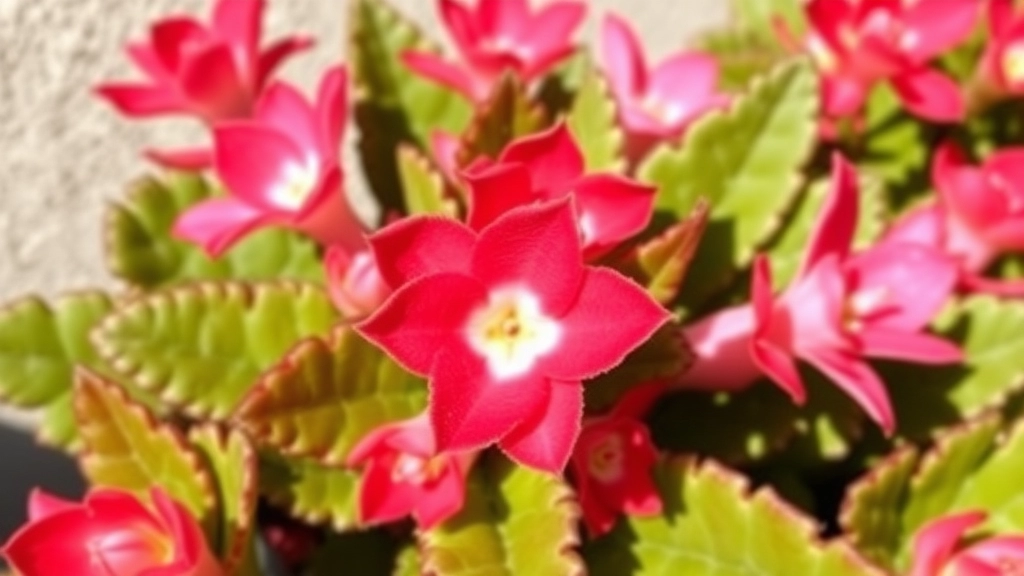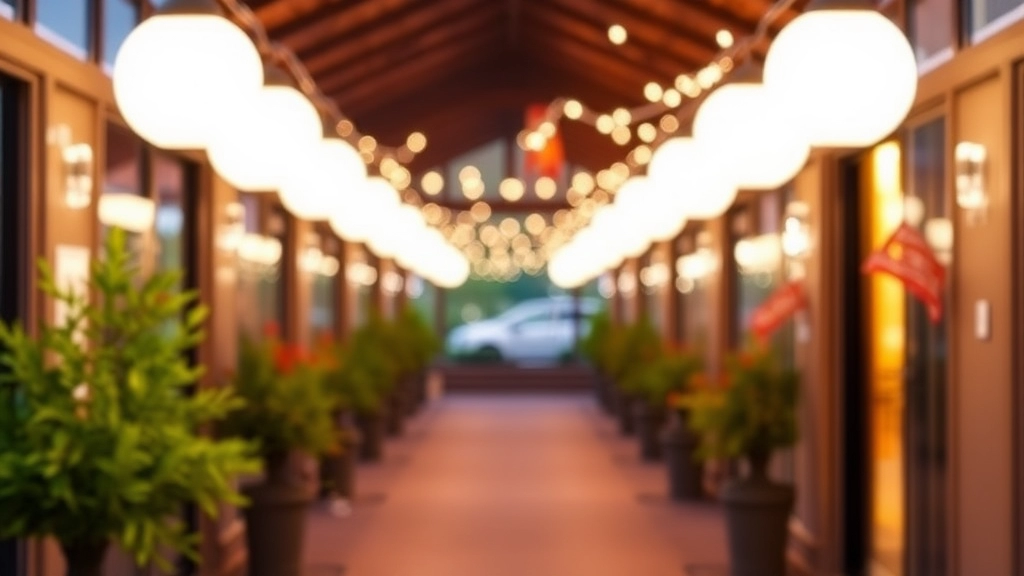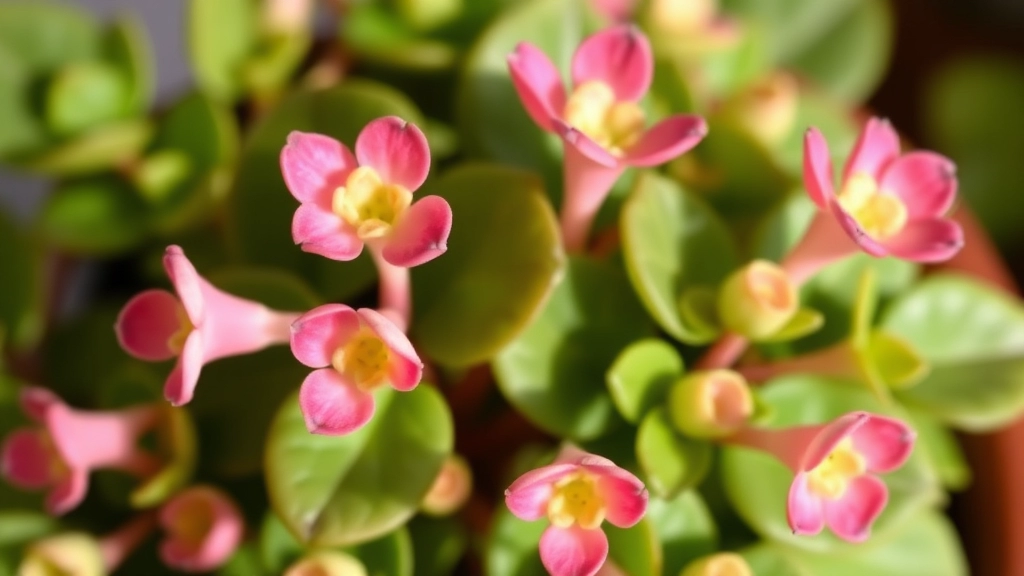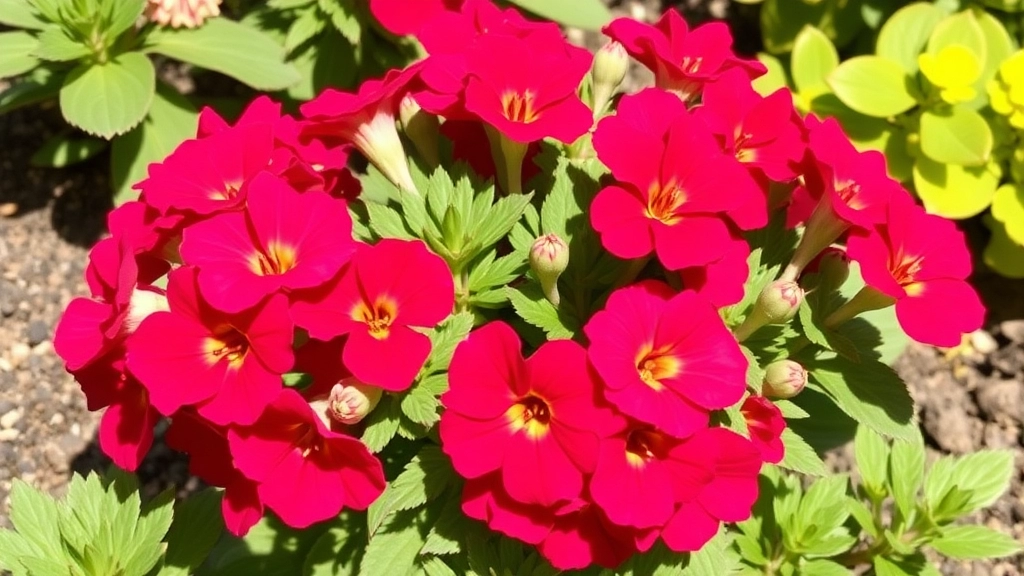Caring for Your Kalanchoe
When it comes to caring for your Kalanchoe, understanding whether it thrives in full sun or shade is crucial. This vibrant succulent is a favourite among plant enthusiasts for its colourful blooms and easy maintenance. But to keep it looking its best, you need to know the right lighting conditions.
From my experience, Kalanchoe plants do best with a mix of both. They love bright, indirect sunlight but can tolerate some direct sun. However, too much direct sunlight can scorch their leaves. On the flip side, too much shade can lead to leggy growth and fewer flowers. Finding that perfect balance will ensure your Kalanchoe remains healthy and vibrant.
Optimal Light Conditions for Kalanchoe
When it comes to nurturing Kalanchoe, one of the most pressing concerns is ensuring it receives the right light.
Kalanchoe thrives under specific light conditions, which can significantly influence its health and blooming potential.
Key Light Requirements for Kalanchoe:
- Bright, Indirect Light: Kalanchoe flourishes best in bright, indirect sunlight. This mimics its natural habitat, allowing it to photosynthesize effectively without burning.
- Avoid Harsh Sunlight: While Kalanchoe can tolerate some direct sunlight, prolonged exposure can lead to leaf scorch, affecting its overall vitality.
- Rotate Regularly: To promote even growth, rotate your Kalanchoe every few weeks. This ensures all sides receive adequate light, preventing lopsided growth.
- Supplemental Lighting: For indoor growers, especially during shorter days, consider using grow lights to maintain optimal light levels.
Understanding these light conditions is crucial for fostering a healthy Kalanchoe. For more tips on how to care for your plant, check out our Ultimate Guide to Flowering Kalanchoe Care Tips for Blooming. Additionally, if you’re interested in propagating your plant, don’t miss our Step-by-Step Guide on How to Propagate Leggy Kalanchoe.
Effects of Full Sun on Kalanchoe

So, you’re thinking about giving your Kalanchoe a sunbath?
While these vibrant plants love light, full sun can sometimes be a double-edged sword.
What Happens in Full Sun?
When your Kalanchoe is exposed to full sun, it might seem like a good idea at first. After all, they’re succulents, right? Here’s the scoop on what can happen:
- Leaf Burn: Too much direct sunlight can scorch those lovely leaves. You might notice brown, crispy edges or even entire leaves turning brown.
- Stunted Growth: Believe it or not, too much sun can actually hinder growth. Instead of thriving, your Kalanchoe may become leggy as it stretches for a bit of shade.
- Color Changes: While some sun can enhance their vibrant colours, too much can fade them out. You want those rich greens and reds, not a washed-out plant!
Finding the Balance
If you’re set on full sun, consider these tips:
- Gradual Exposure: If you’re moving your Kalanchoe outdoors, do it gradually. Start with a few hours of sun and increase exposure over time.
- Monitor Conditions: Keep an eye on the weather. If it’s particularly hot or windy, your plant might need some shelter.
- Water Wisely: Full sun means more evaporation. Ensure you’re watering adequately, but not overdoing it.
Benefits of Partial Shade for Kalanchoe
As we explore the optimal light conditions for Kalanchoe, it’s essential to consider the advantages of partial shade. Many plant enthusiasts often wonder if their Kalanchoe will thrive in less than full sun.
1. Protection from Intense Sunlight
Kalanchoe can be sensitive to excessive sunlight.
- Reduced Leaf Burn: Partial shade helps prevent leaf burn, which is a common issue when Kalanchoe is exposed to harsh midday sun.
- Maintained Colour: The vibrant colours of Kalanchoe can fade in full sun. In partial shade, the plant retains its lush appearance.
2. Balanced Growth
In partial shade, Kalanchoe experiences more balanced growth.
- Stronger Stems: Adequate light without overwhelming intensity encourages the development of sturdy stems.
- Controlled Flowering: Kalanchoe is known for its beautiful blooms. Partial shade can help regulate flowering, leading to more prolonged and vibrant displays.
3. Moisture Retention
Another significant benefit of partial shade is moisture retention.
- Reduced Watering Needs: Less intense sunlight means that the soil retains moisture longer, reducing the frequency of watering.
- Healthy Root System: Consistent moisture levels promote a healthier root system, essential for overall plant vitality.
4. Adaptability to Varied Conditions
Kalanchoe is a resilient plant, but it thrives best with a bit of flexibility.
- Seasonal Adjustments: In seasons where sunlight is more intense, partial shade can be a refuge, allowing the plant to adapt without stress.
- Indoor Versatility: For indoor gardening, placing Kalanchoe near a window with filtered light can yield excellent results.
For more detailed guidance, check out our complete guide to caring for Kalanchoe succulents and discover the ultimate guide to growing and caring for Kalanchoe.
Seasonal Light Requirements

As we explore the seasonal light requirements for Kalanchoe, it’s essential to understand how these changes can impact your plant’s health and growth.
Spring and Summer:
During the warmer months, Kalanchoe thrives in bright, indirect sunlight.
- Optimal Light: Aim for 6-8 hours of filtered sunlight daily.
- Placement: A south or west-facing window works wonders.
- Watering Needs: Increased light often leads to faster growth, so adjust your watering schedule accordingly.
Autumn and Winter:
As days shorten, your Kalanchoe will require different care.
- Reduced Light: Aim for 4-6 hours of bright, indirect sunlight.
- Placement: Move your plant closer to a light source, like a south-facing window.
- Dormancy: Be aware that Kalanchoe may enter a dormant phase, requiring less water.
Key Tips:
- Monitor Sunlight: Use sheer curtains to diffuse harsh light, especially in summer.
- Rotate Your Plant: Every few weeks, give your Kalanchoe a gentle turn to ensure even light exposure.
When considering the optimal light conditions for Kalanchoe, it’s essential to differentiate between indoor and outdoor environments. Many plant enthusiasts often wonder how to best cater to their Kalanchoe’s light requirements, especially when transitioning between these two settings.
### Indoor Light Needs
Kalanchoe thrives in bright, indirect sunlight when grown indoors. Here are some key points to consider:
– **Location**: Place your Kalanchoe near a south or west-facing window for maximum light exposure.
– **Duration**: Aim for 12-14 hours of light daily. If natural light is insufficient, consider using grow lights.
– **Avoiding Burn**: Direct sunlight can scorch the leaves, so filtered light is ideal.
### Outdoor Light Needs
When it comes to outdoor growth, Kalanchoe benefits from a different approach:
– **Full Sun Exposure**: Kalanchoe can tolerate full sun conditions, especially during cooler months.
– **Temperature Considerations**: Ensure that the outdoor temperature is suitable, as extreme heat can stress the plant.
– **Protection from Elements**: Provide some shade during the hottest part of the day to prevent leaf burn.
In summary, while Kalanchoe can adapt to both indoor and outdoor settings, understanding their specific light needs in each environment is crucial for thriving growth. For more detailed information, you can check out the [optimal light for Kalanchoe](https://planthq.org/optimal-light-for-kalanchoe-full-sun-or-shade/) and how Kalanchoe can thrive in [full sun conditions](https://planthq.org/can-kalanchoe-thrive-in-full-sun/).
Signs of Light Stress in Kalanchoe

Ever noticed your Kalanchoe looking a bit off? Light stress can be sneaky, and it’s crucial to catch it early.
When your plant isn’t getting the right amount of light, it can show some pretty clear signs. Here’s what to look for:
- Leggy Growth: If your Kalanchoe is stretching towards the light, it’s a sign it’s not getting enough. You’ll see elongated stems and fewer leaves.
- Leaf Discoloration: Yellowing leaves could mean too much direct sunlight or not enough light. It’s a balancing act!
- Dropping Leaves: If your Kalanchoe starts shedding leaves, it might be stressed from too little light or sudden changes in light conditions.
- Wilting or Soft Leaves: This can happen when your plant is getting too much sun, causing it to dry out faster than it can cope.
- Sunburn: Look for brown, crispy patches on the leaves. This is a telltale sign of too much direct sunlight.
So, if you notice any of these signs, it’s time to reassess your Kalanchoe’s light situation.
Adjusting Light Conditions for Healthier Growth
As we explore the importance of light conditions for Kalanchoe, it’s crucial to understand how to adjust these conditions for optimal growth.
Are you noticing your Kalanchoe struggling?
Here are some practical steps to help you adjust light conditions:
- Assess Current Light Levels: Check where your plant is situated. Is it too bright or too dim?
- Move the Plant: If your Kalanchoe is in direct sunlight for too long, consider relocating it to a spot with filtered light. Conversely, if it’s not getting enough light, try moving it closer to a window.
- Use Sheer Curtains: If you want to soften the intensity of direct sunlight, sheer curtains can diffuse the light without blocking it completely.
- Rotate Regularly: Rotating your Kalanchoe every few weeks ensures that all sides receive equal light, promoting balanced growth.
- Monitor Seasonal Changes: As seasons change, so do light conditions. Be ready to adjust your plant’s location accordingly.
- Consider Grow Lights: If natural light is insufficient, especially during winter months, invest in grow lights. These can provide the necessary spectrum for healthy growth.
By making these adjustments, you can significantly enhance the health of your Kalanchoe, allowing it to thrive in its environment. For more detailed guidance, check out our Optimal Light for Kalanchoe guide. Additionally, if you are experiencing issues with your plant, our guide on yellowing leaves might provide the solutions you need.
Common Mistakes in Light Exposure
We’ve all been there, right? You think you’re giving your Kalanchoe the best light possible, but somehow, it just isn’t thriving. Let’s dive into some common mistakes that can mess with your plant’s light exposure.
1. Overexposure to Direct Sunlight
It’s easy to believe that more sun equals more growth. But too much direct sunlight can scorch those beautiful leaves.
- Signs of Overexposure:
- Brown, crispy leaf edges
- Leaves looking bleached or faded
2. Neglecting Seasonal Changes
Seasons change, and so do light conditions. Just because your Kalanchoe thrived in summer doesn’t mean it’ll enjoy the same spot in winter.
- Tip:
- Move your plant closer to a window during shorter days.
3. Ignoring Indoor Light Levels
If you’re keeping your Kalanchoe indoors, don’t underestimate how much natural light it needs. A dim room can stunt its growth.
- Solution:
- Consider using grow lights if natural light is lacking.
4. Not Rotating Your Plant
Ever notice how one side of your plant looks healthier than the other? That’s likely because it’s not getting even light exposure.
- Quick Fix:
- Rotate your Kalanchoe every couple of weeks for balanced growth.
5. Forgetting to Check for Obstructions
Is your plant sitting behind a curtain or a piece of furniture? Even a little blockage can cut down on light significantly.
- Action Step:
- Evaluate its surroundings and ensure nothing is hindering light access.
For more detailed care tips, check out our guide on maximizing the lifespan of your Kalanchoe. If you need specific advice on dealing with seasonal changes, our article on whether Kalanchoe can thrive in full sun provides valuable insights.
FAQs About Kalanchoe Light Requirements
Does Kalanchoe prefer full sun or shade?
Kalanchoe plants thrive in bright, indirect sunlight. While they can handle some direct sun, too much can cause issues like leaf burn and stunted growth.
What happens if my Kalanchoe gets too much sun?
Excessive direct sunlight can lead to leaf burn, stunted growth, and faded colors. You might notice brown, crispy edges or entire leaves turning brown.
Can I gradually expose my Kalanchoe to full sun?
Yes, gradual exposure is recommended. Start with a few hours of sun and increase the duration over time to help your plant adjust.
What are the seasonal light requirements for Kalanchoe?
In spring and summer, aim for 6-8 hours of filtered sunlight daily. In autumn and winter, reduce this to 4-6 hours of bright, indirect sunlight.
How should I place my Kalanchoe indoors?
During warmer months, a south or west-facing window is ideal. In colder months, move your plant closer to a light source, like a south-facing window.
What are the signs of light stress in Kalanchoe?
Signs of light stress include leggy growth, leaf discoloration, dropping leaves, wilting or soft leaves, and sunburn. If you notice any of these, reassess your plant’s light exposure.
How can I prevent my Kalanchoe from getting too much sun?
Use sheer curtains to diffuse harsh light, especially in summer. Rotate your plant every few weeks to ensure even light exposure.
How does light affect Kalanchoe’s watering needs?
Increased light often leads to faster growth, requiring more frequent watering. However, be cautious not to overwater, especially if the plant is in full sun.
What should I do if my Kalanchoe enters a dormant phase?
During dormancy, which often occurs in autumn and winter, your Kalanchoe will require less water. Adjust your watering schedule accordingly.
Can Kalanchoe handle windy conditions?
If it’s particularly hot or windy, consider providing some shelter for your Kalanchoe to prevent stress and damage.
References
-
Kalanchoe Light Requirements
-
Growing Kalanchoe Indoors
-
Kalanchoe Plant Care Tips
